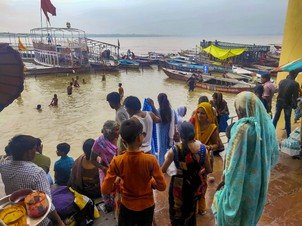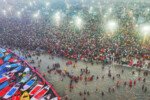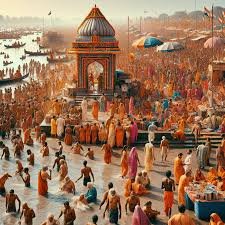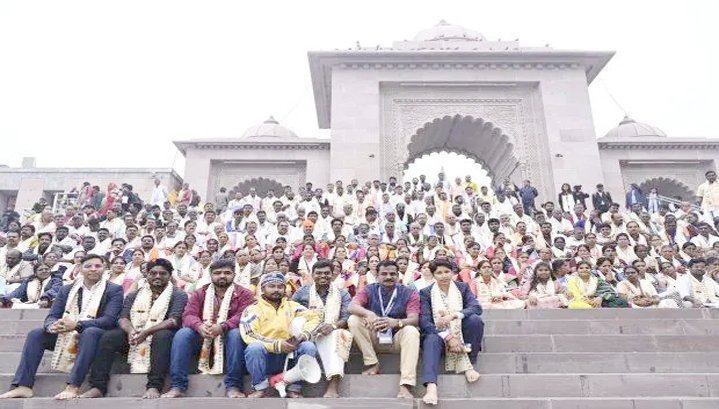VARANASI, Aug 13 (PTI): A Nandi statue faces the Kashi Vishwanath temple at the centre of Varanasi’s
Godowlia crossing, continuing the centuries-old tradition of the guardian deity pointing in the direction
of Lord Shiva’s abode. Just behind, a massive screen plays a cola commercial, the flickering images
fading into a call to buy advertising space.
Benares, as the city was once known, is “older than history, older than tradition, older even than
legend”, Mark Twain famously wrote. But the fabled city of temples, ghats and soul searching is
transitioning – tradition and modernness in tow – into a centrepiece of the government’s promotion of
religious tourism.
Prime Minister Narendra Modi, in a recent Mann Ki Baat address, said the recent jump in the number of
tourists in Varanasi, reflects a “cultural reawakening.”
According to Uttar Pradesh tourism department’s official website, the city has 10 times the number of
tourists it had before the Covid pandemic. In 2019, the total number of tourists in the city amounted to
nearly 68 lakh. Four years later, it matches that figure in one month alone with nearly 7.2 crore tourists
in 2022. During Covid in 2020, the number had dropped to under 10 lakh.
This makes Varanasi, a city with over 12 lakh people according to the last census, the most visited city in
Uttar Pradesh – more than Mathura which topped the list with 6.5 crore tourists in 2022. Agra, the city
of the Taj Mahal, gets the most number of foreign tourists though.
Most people point to the redevelopment of the Kashi Vishwanath Dham Corridor as the reason for the
massive rise in tourist footfall to the city that has long combined mysticism with its many ‘touristy’
attractions – the Ganga cruise, the famed ‘aarti’ and its age-old craft of weaving.
According to Kashi Vishwanath Temple Trust CEO Sunil Verma, 10 crore tourists have visited the temple
since the inauguration of the corridor in December 2021. The corridor – which has been instrumental in
the boom in Varanasi’s tourism sector – is spread across 5 lakh square feet with long queues of devotees
raising slogans of “Har Har Mahadev” intermittently as they await their turn for ‘darshan’.
“About 1-1.5 lakh devotees visit the temple on a daily basis. During the ongoing Sawan month, it has
gone up to 1.5 lakh-2 lakh per day,” Verma told PTI.
Many tourists say the new corridor is what has brought them to the eastern Uttar Pradesh city on the
banks of the Ganges.
“The government’s efforts [in revamping the temple] have made things easier now. There have been
many improvements from before. Facilities both for darshan and for staying here are great,” said Sanjay
Modi, a tourist from Gujarat.
“Every Hindu should visit Kashi once,” added his wife Avani.
Banaras Hindu University student Satyam Srivastava said the modernisation of ghats and the
redevelopment of the temple has contributed vastly to the city’s tourism boom. “It is also part of the
government’s ideology to make the country culturally rich,” he said.
According to his friend Amit Kumar Rao, “the crowd has gone up in the city but there is no
inconvenience.”
Godowlia, the bustling heart of the city, teems with tourists, lakhs of them daily, who walk with
determination towards the revamped temple or the Dashashwamedh Ghat, among other places,
immune to the chaos of the aggressive honking of two-wheelers, overenthusiastic tour guides as well as
the rain, frequent this time of the year.
Some tourists said that unlike other religious cities such as Haridwar, a trip to Varanasi is cheap. Others
pointed out that the controversy surrounding the Gyanvapi mosque is another reason for the recent
interest in the city.
Rohit Raghav, a tourist from Delhi, said apart from a visit to the temple and the ghats, some are curious
about the distance between the mosque and the temple and want to see it for themselves.
The Gyanvapi-Kashi Vishwanath dispute refers to the contested claim that the mosque was built on the
ruins of the temple. The mosque is currently being surveyed by the Archaeological Survey of India after a
Varanasi court order on the matter.
The surge in tourism has led to the mushrooming of scores of hotels, bed and breakfasts, and lodges.
Customers have doubled since the redevelopment of the temple corridor, said Hotel Ganges Grand
general manager Anand Srivastava.
“The demand for hotels has created a shortage of supply which is also driving up the prices,” he said.
While some shopkeepers said there has been an increase in sales, there are those who say there has
been no real change in their income.
“There are more tourists in the city but it has not yielded in more sales,” said Binod Sahni, the owner of
a shop selling Banarasi saris.
Varanasi Development Authority Vice Chairman Abhishek Goyal said the administration has tried to tap
into the economic potential of tourism in the city. “We keep a tab on tour operators, hotels and the
trade bodies who have told us that their economic potential has improved – by a lot,” he told PTI.
Goyal said income has increased but it is too soon to accurately measure changes in the local economy.
Asked if the infrastructure of the city, Modi’s parliamentary constituency, is able to meet the demands
of the increased number of tourists, Goyal said, “There is some stress of course… The city is in a
transitionary phase. There are many projects in the pipeline that are waiting to be completed.”
The demand and supply graphs are constantly changing, he said. The VDA official also pointed out that
many infrastructure related changes such as the new ring road and the expansion of the city airport’s
runway are big long-term projects.
Ratnesh Verma, founder and secretary of Subah-e-Banaras – an early morning programme at the ghat
with aarti, music, yoga and Vedic chanting – said the recent changes in the city reflect the continuation
of “tradition amid the process of modernisation”.
For some locals of the city, however, the increased number of tourists has an unfortunate flip side.
Tanya Khatri, a student who has grown up in Varanasi, said tourism is good for visitors and local
businesses but residents are forced to live with the inconveniences that come with it – traffic and
pollution.
Ashwini Agrawal, another local, pointed to a sea of crowd around the pandits carrying out Ganga aarti at
Assi Ghat and said, “They are all tourists, locals have to stand far behind.”
He said coming to the ghats is now tough because of the struggle to find space for parking.
“The vibe of Varanasi was different before,” Agarwal said.
“Everything has a natural quality,” 75-year-old Narendra Jaiswal said. Pointing to a small, old Hanuman
temple at the ghat, he said, “If you build a wall around it and beautify it, the temple will lose its ancient,
natural essence.”
As Varanasi strides towards the future, balancing the old and the new, the concerns perhaps are
inevitable. As inevitable as the march of time, which has ticked on for centuries in this ancient town.







